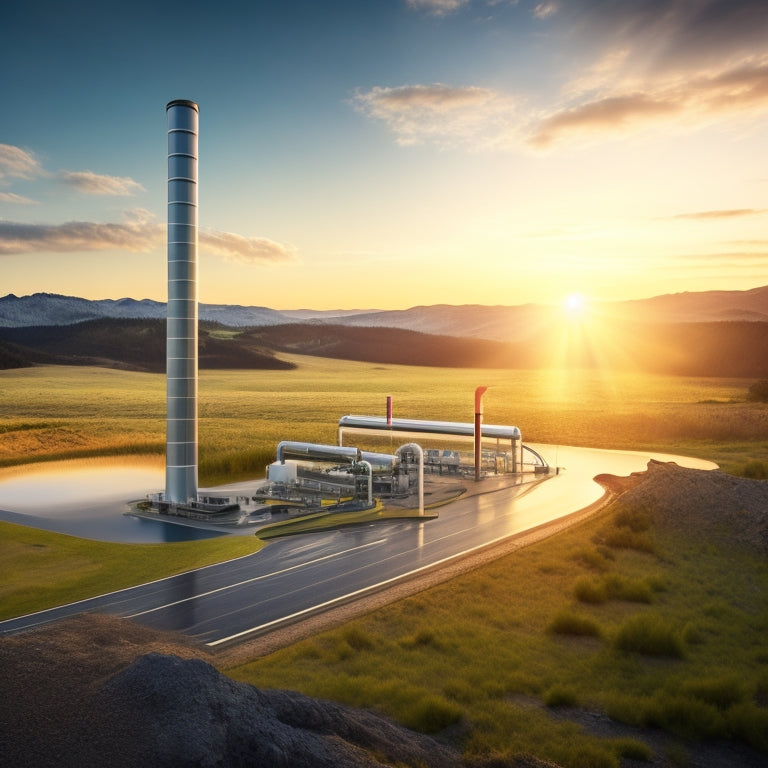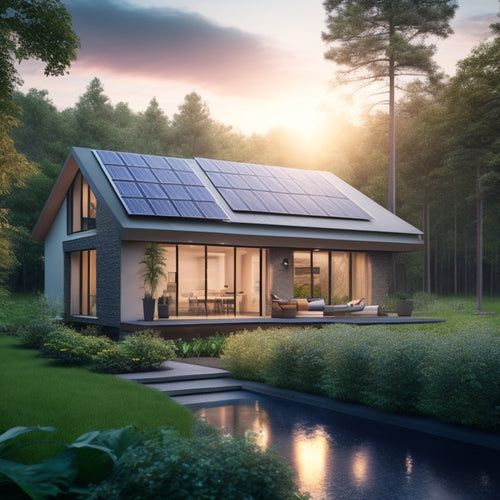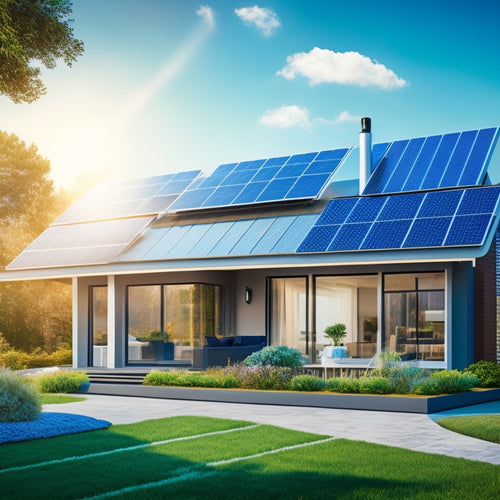
Maximize Geothermal Efficiency: Your Step-by-Step Guide
Share
By optimizing your geothermal system's design, installation, and operation, you can release up to 400% efficiency, considerably reducing your energy costs and carbon footprint. To maximize performance, focus on proper system sizing, accurate load calculations, and integration of renewable energy sources. Select pipe materials with high thermal conductivity, corrosion resistance, and suitable insulation properties. Optimize flow rates and pressure, and guarantee effective heat exchanger sizing. Choose the right ground loop configuration for your site, and prioritize regular monitoring and maintenance. By following these guidelines, you'll be well on your way to utilizing the full potential of geothermal energy and achieving a sustainable, cost-effective solution for your thermal needs.
Key Takeaways
- Proper system sizing and design ensure optimal geothermal energy harnessing and reduced energy costs.
- Selecting high thermal conductivity pipe materials with corrosion resistance and insulation properties enhances energy transfer efficiency.
- Accurate heat exchanger sizing strategies, including fouling allowance and thermal conductivity analysis, support optimal system performance.
- Ground loop configuration options, such as horizontal, vertical, and pond loops, impact overall system performance and energy savings.
- Regular monitoring and maintenance, including temperature, pressure, and flow rate checks, prevent corrosion and scaling issues, ensuring peak operation.
Understanding Ground Source Heat
Your building's thermal comfort relies heavily on utilizing the earth's natural temperature, a concept known as ground source heat. This natural phenomenon allows you to access the earth's consistent ground temperature, which remains relatively constant throughout the year.
By utilizing this geothermal energy, you can reap significant benefits, including reduced energy costs and a decreased carbon footprint. The earth's natural temperature ranges from 40°F to 70°F, depending on your location, making it an ideal thermal reservoir.
Fleet owners can also investigate renewable energy solutions to reduce their reliance on fossil fuels and lower emissions. Furthermore, incorporating geothermal energy into their operations can contribute to a cleaner, more sustainable transportation sector.
System Design and Installation
When designing a geothermal system, you'll need to carefully consider system sizing to guarantee it can handle your heating and cooling demands.
You'll also need to select the right pipe material, as it can greatly impact the system's overall efficiency and longevity.
Additionally, integrating renewable energy sources, such as solar-powered charging solutions, can further reduce your carbon footprint and energy costs.
System Sizing Considerations
Properly sizing a geothermal system is crucial to maximize its efficiency and guarantee a comfortable, consistent indoor climate. You'll need to perform accurate load calculations to determine the required system size. Consider seasonal variations, including peak heating and cooling demands, to confirm your system can handle the fluctuations.
| System Component | Sizing Factor | Consideration |
|---|---|---|
| Heat Pump | Peak heating load | Calculate heating demand during extreme cold snaps |
| Ground Loop | Soil thermal conductivity | Account for soil type and moisture levels |
| Distribution System | Pipe sizes and layout | Confirm adequate fluid flow and minimal pressure drops |
| Storage Tank | Capacity and insulation | Size for ideal heat storage and reduced heat loss |
Pipe Material Selection
The backbone of a geothermal system, the piping network, demands careful consideration of material selection to guarantee efficient heat transfer, durability, and cost-effectiveness.
You'll want to select pipes with high thermal conductivity to maximize energy transfer. Corrosion resistance and fluid compatibility are also essential, as they directly impact pipe durability and overall system lifespan. Insulation properties should also be considered to minimize heat loss.
Additionally, consider the environmental impact and installation costs of different materials. In addition, integrating renewable energy sources, such as solar power, can greatly reduce carbon footprint and enhance eco-friendliness, making it an ideal choice for environmentally conscious homeowners.
Similarly, reducing reliance on fossil fuels can lower greenhouse gas emissions and promote a sustainable future.
PEX, for instance, is a popular choice due to its flexibility, corrosion resistance, and low installation costs. Copper, on the other hand, offers high thermal conductivity but may be more expensive.
Weigh these factors carefully to guarantee your pipe material selection optimizes your geothermal system's performance.
Pipe Material Selection Matters
Your geothermal system's pipes are its lifeblood, conveying essential fluids between the earth and the surface. When selecting pipe materials, you must consider several vital factors to guarantee maximum efficiency.
Implementing sustainable fuel options like electrification and biodiesel reduces greenhouse gas emissions and pipe durability and thermal conductivity are essential, as they impact heat transfer and energy losses. Installation techniques, cost considerations, and corrosion resistance also play a significant role.
You'll need to choose materials that can withstand the fluid type and environmental conditions. Insulation materials should also be selected based on their thermal performance and durability.
Flow Rate and Pressure Optimization
You'll need to pinpoint ideal flow rates for your geothermal system, as excessive or insufficient flow can negatively impact efficiency.
Regular system pressure checks are also essential, as even slight variations can affect heat transfer and overall performance.
Securing energy independence mitigates volatility in fuel prices and enhances operational efficiency through solar energy utilization.
Optimal Flow Rates
Maximizing geothermal efficiency relies heavily on ideal flow rates, which involve finding the perfect balance between flow rate and pressure. You need to verify that your system operates within the ideal flow rate range to maximize heat transfer and minimize energy losses.
| Flow Rate (GPM) | Temperature Differentials (°F) | Seasonal Adjustments |
|---|---|---|
| 3-5 | 5-10 | Winter: +10%, Summer: -5% |
| 5-7 | 10-15 | Spring: +5%, Autumn: -10% |
| 7-10 | 15-20 | Monsoon: -15%, Dry: +15% |
System Pressure Checks
Efficiency hinges on the delicate interplay between flow rate and pressure, and system pressure checks are crucial in maintaining this balance.
You'll need to verify that your system pressure is within the recommended operating range, as specified by the manufacturer. Make pressure adjustments as needed to guarantee ideal performance.
Conduct regular system pressure checks to identify any issues before they become major problems. This proactive approach will help you avoid downtime, reduce energy consumption, and maximize your geothermal system's efficiency.
Flow Velocity Control
By guaranteeing system pressure is within the ideal range, you've laid the groundwork for fine-tuning your geothermal system's performance.
Now, it's time to maximize flow velocity control, which directly impacts pump performance and overall system efficiency.
To achieve maximum flow velocity, consider the following:
-
Monitor flow rates: Verify they're within the recommended range for your system to prevent erosion, corrosion, and excessive pressure drops.
-
Adjust pump speed: Fine-tune pump performance by adjusting speed to match changing system demands, thereby minimizing energy waste and maximizing efficiency.
-
Analyze fluid behavior: Study flow patterns, pipe sizes, and fittings to identify areas of turbulence and enhance system design for smooth, efficient fluid flow.
Heat Exchanger Sizing Strategies
Designing a geothermal system requires a thorough understanding of heat exchanger sizing strategies, as undersized or oversized heat exchangers can lead to reduced system performance and increased energy costs. You must consider factors such as heat transfer efficiency, thermal conductivity analysis, and fluid flow rates to guarantee ideal system operation.
| Sizing Strategy | Description |
|---|---|
| Rule of Thumb | Use industry-standard guidelines for heat exchanger sizing, such as 10-20% excess capacity for fouling allowance. |
| Heat Transfer Analysis | Perform detailed heat transfer calculations to determine the required heat exchanger size based on your system's specific conditions. |
| Simulation Modeling | employ simulation software to model your system and enhance heat exchanger sizing for maximum efficiency and performance. |
Ground Loop Configuration Options
In configuring your geothermal system, you'll need to contemplate the ground loop configuration options that best suit your project's unique requirements.
This decision will greatly impact your system's overall performance, loop efficiency, and energy savings.
-
Horizontal Loops: Suitable for large, open spaces, these loops are typically installed in trenches, providing a cost-effective solution for shallow installations.
-
Vertical Loops: Ideal for smaller areas, these loops are installed in boreholes, offering a more compact design and higher ground heat exchange rates.
-
Pond Loops: If you have a nearby pond or lake, you can employ the natural heat sink, eliminating the need for a traditional loop field and trench systems, while providing a highly efficient installation technique.
Monitoring and Maintenance Essentials
Three essential factors - efficiency, reliability, and longevity - hinge on your ability to effectively monitor and maintain your geothermal system.
By implementing proactive monitoring techniques, you'll identify potential issues before they impact performance. Regularly check system temperatures, pressures, and flow rates to guarantee peak operation.
Create a maintenance schedule that includes tasks like cleaning filters, inspecting pipes, and updating software. This will prevent corrosion, scaling, and other problems that can reduce efficiency.
Frequently Asked Questions
Can Geothermal Systems Be Used in Small or Urban Areas?
You can successfully implement geothermal systems in small or urban areas, as long as you assess geothermal feasibility and carefully plan urban installations, ensuring peak performance and utilizing the earth's energy to fuel your independence.
How Does Geothermal Energy Impact the Environment?
You'll find that geothermal energy has a remarkably low environmental impact, offering a clean and sustainable source of power that supports environmental sustainability, with geothermal benefits including minimal land use, low emissions, and a negligible risk of pollution or habitat disruption.
Are Geothermal Systems Compatible With Radiant Floor Heating?
As you envision a warm, cozy haven, you wonder if geothermal systems can harmonize with radiant floor heating. The answer is yes! Geothermal systems can seamlessly integrate with radiant flooring, amplifying energy efficiency and providing a comfortable, eco-friendly haven that's customized to your freedom-loving spirit.
Can Geothermal Energy Be Used for Cooling as Well?
You can utilize geothermal heat to power cooling systems, providing an efficient and eco-friendly alternative to traditional air conditioning; by reversing the process, you're able to effectively cool your space while reducing your carbon footprint.
Are There Any Government Incentives for Geothermal Installations?
"Money makes the world go round," and you're smart to ask about government incentives for geothermal installations. You'll be pleased to know that you're eligible for federal rebates and local grants, which can greatly offset the costs of your eco-friendly investment, giving you more freedom to live life on your terms.
Related Posts
-

3 Best Eco-Grants for Home Energy Upgrades
You're eligible for various eco-grants that can help you cut down on energy bills and reduce your carbon footprint by...
-

7 Best Cool Roof Rebates for Energy-Savvy Homeowners
You're an energy-savvy homeowner looking to install a cool roof, and you're wondering which rebates can help you save...
-

How to Upgrade Your Home With Geothermal Innovations
You're now on the cusp of utilizing the Earth's natural thermal energy to revolutionize your home's heating and cooli...


